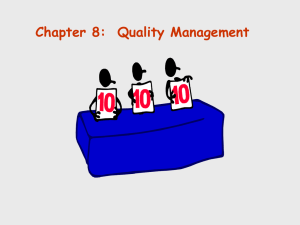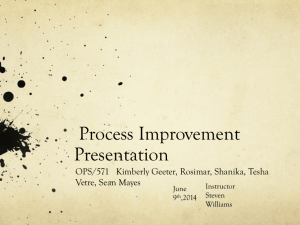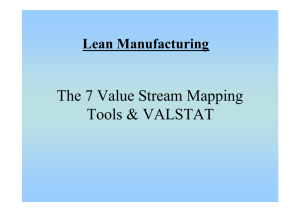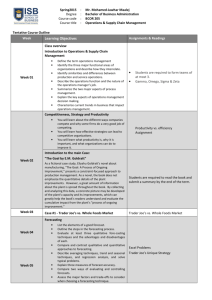OPSM 901: Operations Management
advertisement
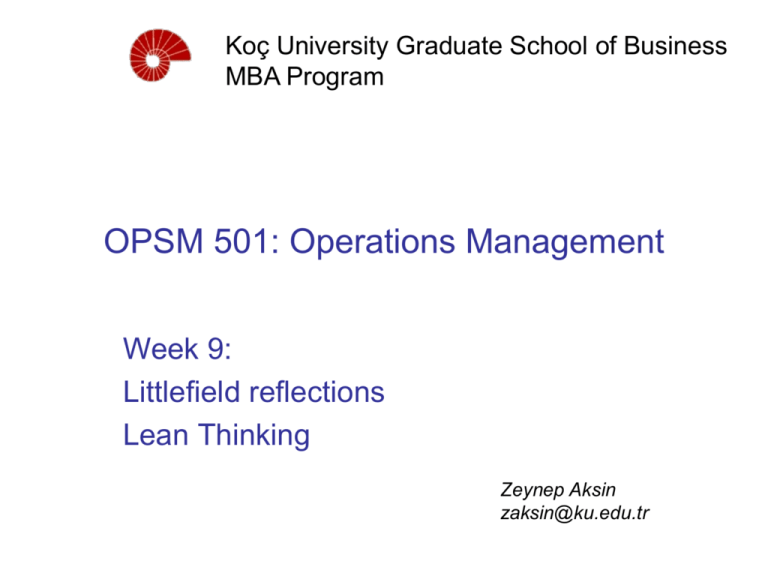
Koç University Graduate School of Business MBA Program OPSM 501: Operations Management Week 9: Littlefield reflections Lean Thinking Zeynep Aksin zaksin@ku.edu.tr Toyota Production System: Why did TPS develop? Economic conditions in Japan after WWII: - low income - low labour productivity - low economies of scale compared to US But car buyers wanted to be offered variety,quality, timeliness and a reasonable price. Toyota was challenged to cut cost dramatically TPS - aimed at cost reduction by thoroughly eliminating waste. Zero non-value added activities (muda) . Zero defects, zero breakdowns, zero inventory, zero set-up Production flow synchronized with demand (JIT) Quality methods to reduce defects One-unit-at-a-time flow Fool-proofing (poka-yoke) and visual feed-back Mixed model production (heijunka) Detect-stop-alert (Jidoka) . Piece-by-piece transfer (ikko-nagashi) Defects at machines (original Jidoka) Match production demand based on Takt time Defects in assembly (Andon cord) Pull instead of push Build-in-quality (tsukurikomi) Supermarket / Kanban Make-to-order Reduce inventory to expose defects Flexibility Adjustment of capacity to meet takt-time Multi-task assignment (takotei-mochi) Standardization of work Reduction of Variability Quartile Analysis Standard operating procedures Worker involvement Quality circles (Kaizen) Fishbone diagrams (Ishikawa) Skill development / X-training The Shingo System: Fail-Safe Design Shingo’s argument: – – Defects arise when people make errors Defects can be prevented by providing employees with feedback on errors and putting controls in the process Poka-Yoke includes: – Checklists – Special tooling that prevents employees from making errors – (Poka-Yoke: Japanese slang for “avoiding inadvertent errors” ) Which dial turns on the burner? Stove A Stove B Pareto Analysis Percentage -100% Frequency -50% A B C D E F -0% Pareto Law (80/20 Rule): “80 percent of the problems are due to 20 percent of the causes” Fish-Bone Diagram Also known as cause-and-effect diagram, or Ishikawa diagram Pareto analysis is used to identify key problems or symptoms, Fish-Bone diagram is used to sort causes of the problems Brain storming sessions of groups of workers needed It is a very valuable educational tool Fish-Bone Diagram Used to find problem sources/solutions Other names – Fish-bone diagram, Ishikawa diagram Steps – Identify problem to correct – Draw main causes for problem as ‘bones’ – Ask ‘What could have caused problems in these areas?’ Repeat for each sub-area. Cause-and-Effect Diagram (Fishbone Diagram) The System of Lean Production (Toyota, Citroen, …) Principles Zero Inventories Zero Defects Flexibility / Zero set-ups Zero breakdowns Zero handling / non value added Organization Autonomation Competence and Training Continuous Improvement Quality at the source Methods Just-in-time Production • Kanban • Classical Push • “Real” Just-in-time Mixed Production Set-up reduction Inventory in process Principles of Lean Production: Zero Inventory and Zero Defects • Avoid unnecessary inventory • To be seen more as an ideal • Two types of (bad) inventory: a. resulting from defects / rework b. absence of a smooth process flow • Remember the other costs of inventory (capital, flow time) Pictures: Citroen Buffer argument: “Increase inventory” Toyota argument: “Decrease inventory” Principles of Lean Production: Zero Set-ups, Zero NVA and Zero Breakdowns Avoid Non-value-added activities, specifically rework and set-ups • Flexible machines with short set-ups • Allows production in small lots • Real time with demand • Large variety • Maximize uptime • Without inventory, any breakdown will put production to an end • preventive maintenance Methods of Lean Production: Just-in-time Push: make to forecast • Classical MRP way • Based on forecasts • Push, not pull • Still applicable for low cost parts Pull: Synchronized production • Part produced for specific order (at supplier) • shipped right to assembly • real-time synchronization • for large parts (seat) • inspected at source Pull: Kanban • Visual way to implement a pull system • Amount of WIP is determined by number of cards • Kanban = Sign board • Work needs to be authorized by demand Methods of Lean Production: Mixed Production and Set-up reduction Production with large batches Cycle Cycle Inventory Inventory Beginning of Month End of Month Production with small batches Produce Sedan Produce Sedan Produce Station wagon Produce Station wagon Beginning of Month End of Month Organization of Lean Production: Autonomation and Training • Automation with a human touch • Create local decision making rather than pure focus on execution • Use machines / tools, but avoid the lights-off factory • Cross training of workers • Develop problem solving skills 10-15 Organization of Lean Production: Continuous Improvement and Quality-at-thesource • Solve the problems where they occur - this is where the knowledge is - this is the cheapest place Defect found End User Own Process Next Process End of Line Final Inspection $ $ $ $ $ • very minor • minor delay • Rework • Significant • Reschedule Rework • Delayed Defect fixed delivery • Overhead • Warranty cost • recalls • reputation • overhead • Traditional: inspect and rework at the end of the process • Once problem is detected, send alarm and potentially stop the production 10-16 Continuous Improvement Represents continual improvement of process & customer satisfaction Involves all operations & work units Other names – Kaizen (Japanese) – Zero-defects – Six sigma Process Improvement Measurement – External and Internal Analysis – Analyze Variation Control – Adjust Process Improvement – Reduce Variation Innovation – Redesign Product/Process P D C A Innovate P D C A Control Improve Improve The River Analogy Defects Defective Materials Machine Breakdowns Long Set ups Long Lead times Unsuitable Equipment Uneven Schedules Unreliable Suppliers Inefficient Layouts Absenteeism Rigid Work Rules Ongoing objectives Improve process flows – Efficient plant layout – Fast and accurate flow of material and information Increase process flexibility – Reduce changeover times – Cross-training Decrease process variability – Flow rates – Processing times – Quality Minimize processing costs – Eliminate transportation, inspection, rework How? Improve process flows – Cellular layouts – Demand pull mechanisms Increase process flexibility – Fast changeovers – Smaller lotsizes, level production Decrease process variability – – – – Standardize Improve supplier reliability and capacity Safety capacity, preventive maintenance Fast feedback and correction Minimize processing costs – Improve quality, eliminate non-value-adding activities Beyond production: Shouldice as a lean enterprise Shouldice General Hospital Focus on low risk cases No focus, multiple goals Clear single value prop. Confusion of value prop. Predictable process Unpredictable process Strive for perfection Strive for threshold perf. Eliminate waste Tolerate some excess Manage patient flows View patients as functional tasks Pull patients into process Push patients through process Womack and Jones (2000) From Lean Production to Lean Enterprise, HBR March-April 1994 Beyond production: Zara as a lean enterprise Zara M&S Clear focus on one customer type and one process No focus, multiple and simultaneous goals Unique and clear value prop. Confusion of implicit value proposition Predictable process Unpredictable and fuzzy process Strive for perfection Satisfied with threshold performance Eliminate waste Tolerate some excess Manage customer flows View customers as a sequence of tasks Pull customers into process Pushes customers through the system Some Japanese Poka-Yoke Kaizen Muda Jidoka Heijunka Kanban Class next week Topic (newsvendor) not included in midterm However there is an in-class activity Please bring your laptop to class, will use some Excel files to do an in-class exercise Will do it in pairs; one laptop per two is enough but make sure you coordinate with each other Midterm exam next week Study from the notes and book Solve some problems from the book: practicing by solving problems is essential for success Go over cases and in-class exercises, games, etc.
